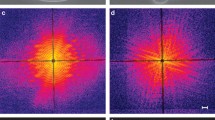Abstract
A new method is proposed for producing point holograms by utilising highly correlated, extended sources rather than point-like sources in the recording process. The theory of this method is presented. Its feasibility is demonstrated experimentally. A multiple imaging experiment is described which utilises this kind of hologram. Advantages and limitations of holograms of extended sources are discussed.
Similar content being viewed by others
Abbreviations
- R :
-
complex amplitude of the reference wavefront in the hologram plane
- S :
-
complex amplitude of the signal wavefront in the hologram plane
- D :
-
complex amplitude of the reconstructing wavefront in the hologram plane
- T :
-
complex amplitude of the reconstructed wavefront in the hologram plane
- r :
-
complex amplitude of the wavefront illuminating the reference transparency
- s :
-
complex amplitude of the wavefront illuminating the reference transparency
- d :
-
complex amplitude of the wavefront illuminating the reference transparency
- t :
-
complex amplitude of the wavefront illuminating the reference transparency
- p :
-
amplitude transmittance of the reference transparency
- σ :
-
amplitude transmittance of the signal transparency
- δ(δ-function):
-
amplitude transmittance of the reconstructing transparency
- τ:
-
amplitude transmittance of the reconstructed transparency
- P r ,P s :
-
propagation functions at distancesz r ,z s , respectively (equation 3)
- x, y :
-
co-ordinates in the source plane
- σ, η :
-
co-ordinates in the hologram plane
- z r ,z s :
-
distances of the reference, signal source from the hologram plane
- X r ,y r :
-
co-ordinates of the reconstructing source (δ-function)
- a, h :
-
shift co-ordinates in the autocorrelation integral (equation 12)
- f r,f s :
-
Fourier transform operator at distances zr,z s (equation 7a) wavelength
- k=2π/λ :
-
wavenumber
- *:
-
conjugate complex
- (*):
-
convolution
References
O. L. Rogers,Nature 166 (1950) 237;W. E. Kock, L. Rosen, andJ. Rendeird,Proc. IEEE 54 (1966) 1599–1601.
G. Groh, Synthetische Phasenhologramme. Holographie-Arbeitstagung, 30 November-1 December 1967, Frankfurt (Main) (Batelle-Institut e.v., Frankfurt (Main)).
M. H. Horman,Appl. Optics 6 (1967) 2011–2013.
M. J. R. Schwar, T. P. Pandya, andF. J. Weinberg,Nature 215 (1967) 239–241.
H. J. Einighammer,Naturwiss. 54 (1967) 641;idem, ibid,55 (1968) 295–296.
Lu Sun,Proc. IEEE 56 (1968) 116–117.
G. Groh,Appl. Optics 7 (1968) 1643–1644.
S. Lowenthal, A. Werts, andM. Rembault,Compt. Rend. 267B (1968) 120–123.
L. K. Anderson,Bell Labs. Record (Nov. 1968) 319–325.
J. W. Goodman, “Introduction to Fourier Optics” (McGraw-Hill, New York, 1968) p. 88.
W. L. Anderson,Phys. Lett. 26A (1968) 384–385.
G. Groh,Appl Optics 8 (1969) 967–969.
R. Linde, private communication.
Author information
Authors and Affiliations
Rights and permissions
About this article
Cite this article
Groh, G. A new method for producing point holograms. Opto-electronics 2, 73–80 (1970). https://doi.org/10.1007/BF01419155
Received:
Issue Date:
DOI: https://doi.org/10.1007/BF01419155




